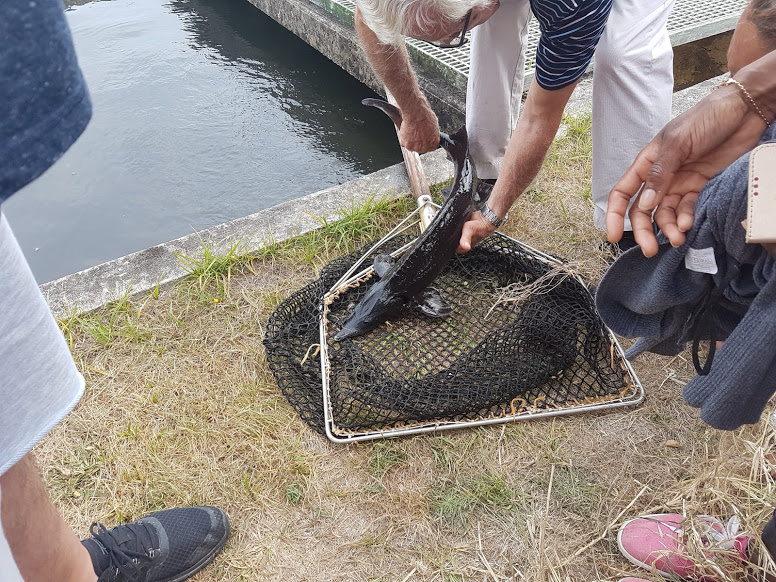Tasting the precious black pearls of Arcachon bay

Curious to know more, we went along to the Perlita strugeon farm near Arcachon on the river Leyre. Here is what we learned:
It is one of the only caviar farms in France to manage the whole cycle on the same site from farming to processing. We also learnt that one of the first criteria of good quality caviar is the size of its grains. Something else that we found amazing was how technical and long the farming is.
The small team is very friendly. We were greeted by Marion and also Jean, a local retired story-teller who looks after the groups that visit the site. Jean is the official guide for the farm as he has acquired extensive knowledge which, combined with his personality, makes it a great experience. He went through the entire production process careful to mention the environmental issues such as water cleaning and local nature preservation. The sturgeon raised here is of the Siberian species. For over 20 years now over 4 tonnes of caviar is produced every year to satisfy the taste buds of French clients and also an increasing large number of foreign clients, restaurants, wholesalers and direct consumers.
We visited the ponds first where the fish are equipped with electronic markers allowing the team to follow the maturation process on a daily basis. This is crucial in deciding the precise moment for collecting the eggs. Over 50,000 fry are born here every year. They are put in different ponds according to their age. Before three years old it’s impossible to know if they are male or female. From seven years old the female fish is kept aside and monitored regularly, until the eggs have reached the best size for consumption.
It’s not possible to visit the laboratory where the extraction is made and the caviar conditioned. But Pierre showed a great video which explains the process in detail.
To finish the visit we were invited to taste two types of caviar, one only a few weeks old the other 7 months old. It was the first time tasting such a delicacy and we loved the refined and iodine taste and appreciated the difference between the young and more mature caviar.
Pierre finally explained that many local restaurants order directly from Perlita, such as the famous Le Chapon Fin in Bordeaux, or Les Belles Perdrix at Château Trolong Mondot in Saint-Emilion. Below is a recipe from the Arcachon restaurant Le Patio where Perlita caviar is on the menu since 2007.
The visit takes 1 hour and 30 minutes and costs €29/person. It includes a very generous Perlita tasting. Note that visits are in French, however Greens & Grapes will be delighted to organise the booking and translation for groups.
You can buy directly from the shop, which will wrap them neatly in a cooling box that can keep it fresh for 48h. Prices start at €42 for a 20g tin.
L’Estrugeonnière – Caviar Perlita – www.caviar-perlita.com
Thank you to Jean and Marion for their welcome and friendliness during the visit.
How to eat caviar?
For aperitif, on its own with Champagne. Here people favour them with oysters from Arcachon: just put a few pearls on each oyster and always best with local dry wine such as Entre-deux-Mers.
Try it also with a Vodka granite and lime sorbet, or prepare small potato pancakes, whip lemon with cream and present caviar on the pancake with the beaten cream on the side.
Pierre recommends it in its simplest form, such as in an organic boiled or just on its own.
At Le Patio restaurant in Arcachon, the chef often cooks it in a Crab soup for starter. The fresh crab meat is presented in the centre of a plate in the shape of a ball. It’s covered with layers of cucumber. The crab soup is delicately poured around the crab ball. A small spoonful of caviar is displayed on top of the ball for contrasting taste and colour.
